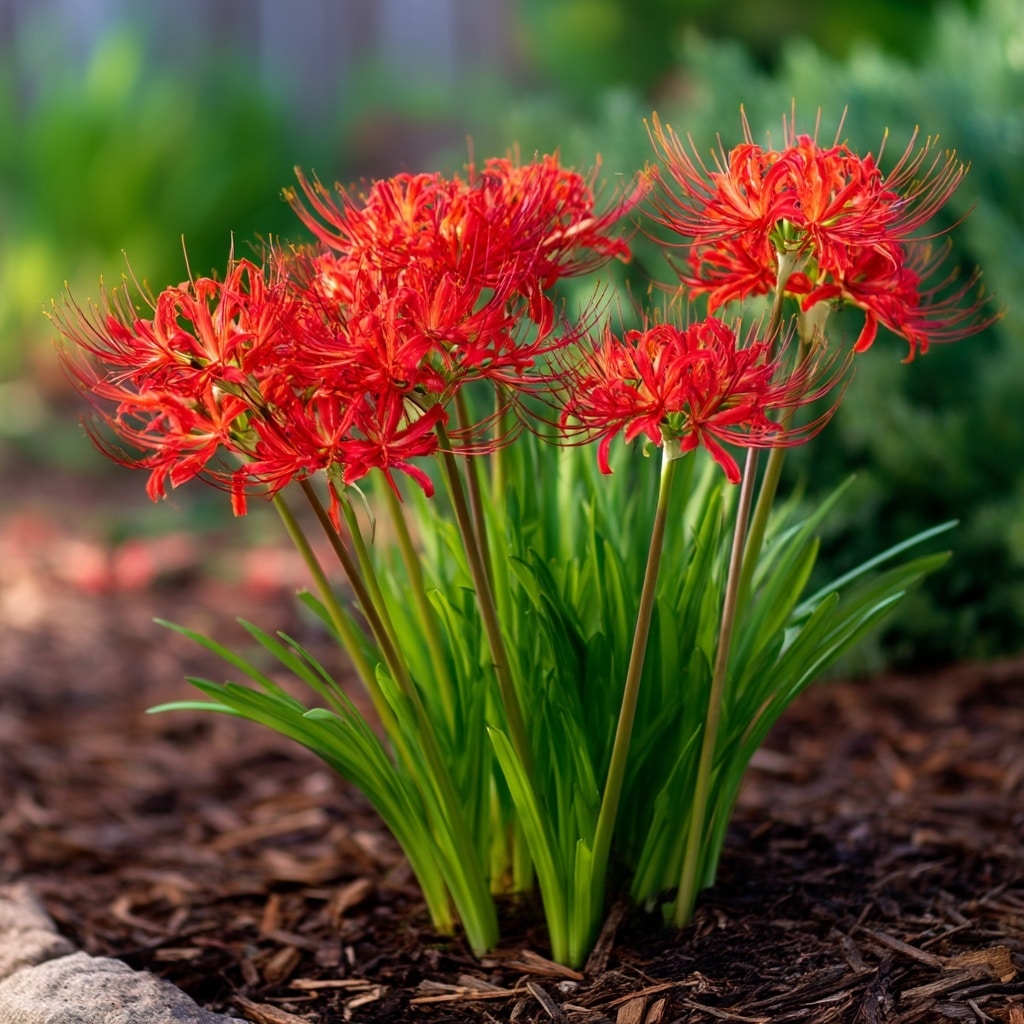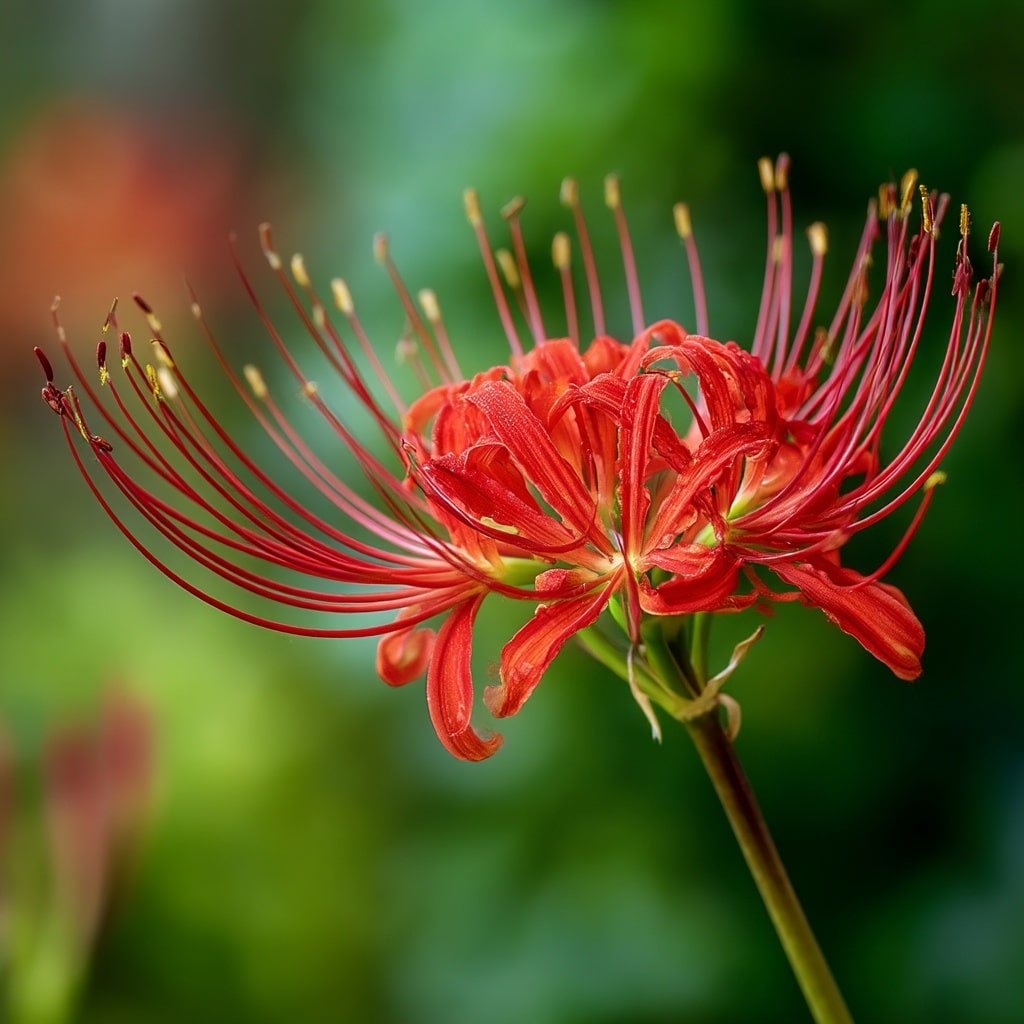If you’re looking for a bold, low-maintenance flower to liven up your late-summer garden, the spider lily might be exactly what you need. Known for its striking red blooms and surprising growth pattern, this perennial bulb adds unexpected color just as many other flowers begin to fade. With its slender, leggy stamens and delicate petals, the spider lily is both unusual and elegant—an excellent conversation starter for any flower bed. Despite its exotic appearance, it’s easy to grow and requires minimal effort once planted correctly, making it a favorite among gardeners from USDA Zone 5b all the way through Zone 10.
Table of Contents
Plant Profile – Understanding Spider Lily Red
The spider lily (Lycoris radiata), often called red spider lily or surprise lily, is a perennial bulb native to Asia and prized for its vivid late-summer blooms. It belongs to the Amaryllidaceae family and thrives in warm, temperate regions with USDA hardiness zones ranging from 6 to 10. This plant typically reaches a height of 1 to 2 feet with a similar spread, making it ideal for compact garden spaces, borders, and naturalized areas.
Quick Botanical Facts:
- Type: Perennial bulb
- Family: Amaryllidaceae
- USDA Zones: 6–10 (sometimes hardy to Zone 5b with protection)
- Height: 1–2 feet
- Spread: 1–1.5 feet
- Bloom Time: Late August through September
- Bloom Color: Brilliant red
- Foliage: Strap-like, gray-green leaves in fall and winter
- Sunlight Needs: Full sun to partial shade
- Water Requirements: Medium, with well-drained soil
- Maintenance Level: Low to medium
- Wildlife Benefits: Attracts bees, butterflies, and hummingbirds
What makes the spider lily truly remarkable is its blooming pattern. The flowers often emerge before the leaves in late summer, producing leafless stalks topped with fiery red, spidery blossoms. This gives the plant a mystical, almost magical quality—hence nicknames like “resurrection flower” and “naked lady.”
Growing Conditions – How to Grow Spider Lily Bulbs Successfully
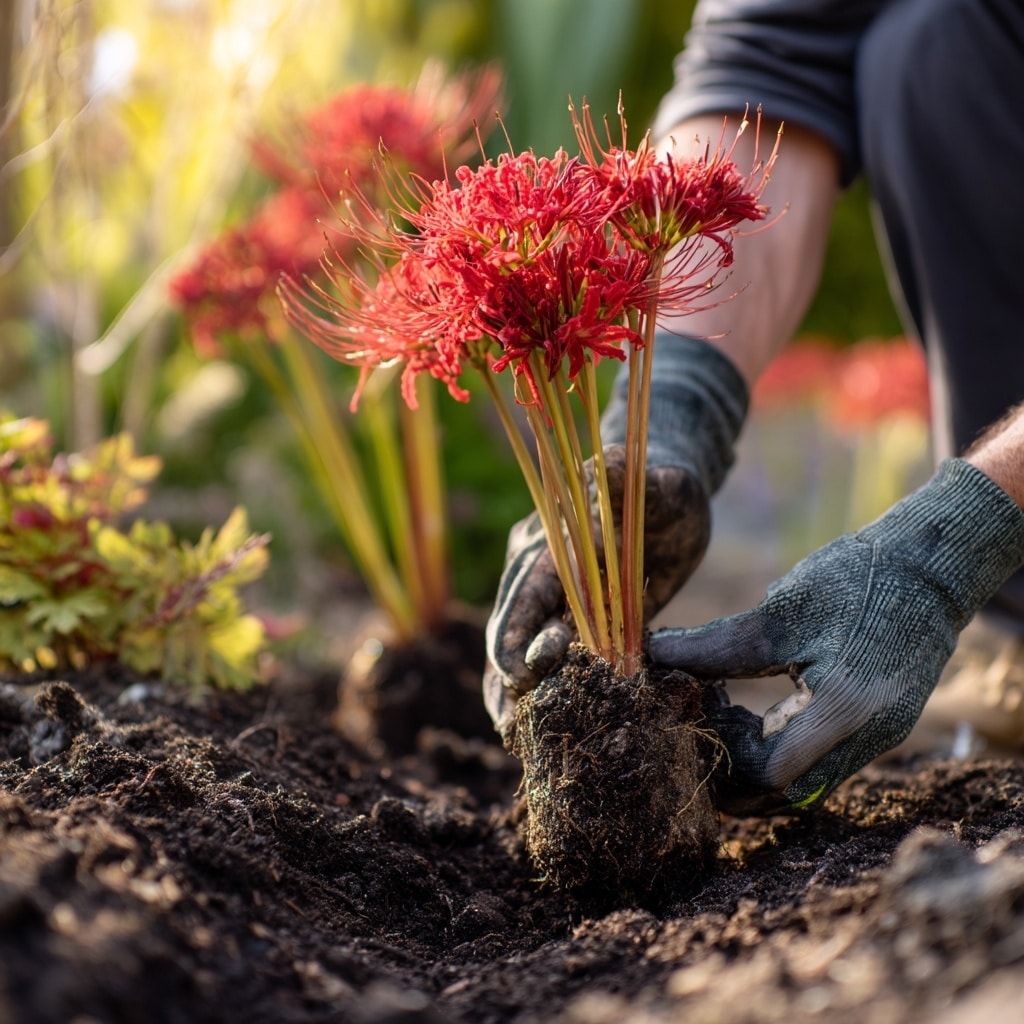
Understanding how to grow spider lily bulbs is key to enjoying their vibrant, late-season blooms year after year. Fortunately, these resilient perennials are easy to care for once established, and with a little planning, they’ll thrive in a wide range of garden settings.
Planting Location & Soil
Spider lilies grow best in organically rich, well-drained soil. They prefer partial shade, especially in hotter climates, but they can also tolerate full sun as long as the soil stays consistently moist during the growing season. Avoid waterlogged spots, as soggy conditions can lead to bulb rot.
🌱 Tip: Raised beds or sloped areas are ideal for improving drainage.
When and How to Plant
- Best time to plant: Early to mid-fall
- Spacing: Place bulbs 8–9 inches apart
- Depth: Keep the neck of the bulb just above soil level—burying them too deep may prevent flowering
The spider lily’s unique blooming pattern depends on bulb placement. For successful bud development, the top quarter of the bulb should remain exposed. This is especially important for flower production the following year.
Watering and Dormancy
Keep the soil evenly moist during active growth in fall and early winter. In summer, when the plant enters dormancy, reduce watering and allow the soil to dry out naturally. This seasonal shift is normal and essential for healthy flowering.
Container Growing
While spider lilies can be grown in pots, they require deep containers to accommodate their long roots. Shallow pots can lead to stunted growth and may prevent blooming. If planting in containers:
- Use a pot at least 12–14 inches deep
- Ensure excellent drainage
- Avoid moving pots frequently, as spider lilies dislike disturbance
Once you’ve learned how to grow spider lily bulbs the right way, they’ll reward you with dazzling, low-maintenance color every year.
Flowering Habits – What Makes Spider Lily Red So Unique

One of the most striking features of the spider lily is its unusual flowering behavior. Unlike most garden plants, the spider lily’s brilliant red blooms appear on bare stalks—before any foliage emerges. This unexpected display gives the plant its common names like “surprise lily”, “resurrection flower”, and “naked lady.”
Bloom Time and Appearance
- Bloom Period: Late August through September
- Flower Color: Vivid coral-red to scarlet
- Flower Shape: Long, reflexed petals with dramatically extended stamens that resemble spider legs
- Flower Size: Up to 2 inches across, arranged in umbels of 4–6 blooms per stalk
- Flower Stalk Height: 12–24 inches
The floral display is bold and eye-catching—each stem rises straight from the soil, without any leaves, producing an ethereal, floating effect that’s hard to miss.
Foliage Timing
After flowering ends, strap-like gray-green leaves begin to emerge in fall. These leaves stay evergreen through winter in mild climates and eventually die back in late spring. This reversed growth cycle—flowers before foliage—adds a sense of mystery and charm to the garden.
Naturalizing Over Time
Once planted, spider lilies tend to naturalize easily, forming attractive clumps or colonies. They reproduce via bulb offsets, meaning one healthy bulb can gradually lead to a whole patch of glowing red flowers with little human intervention.
Pest Resistance and Common Issues – A Low-Maintenance Beauty
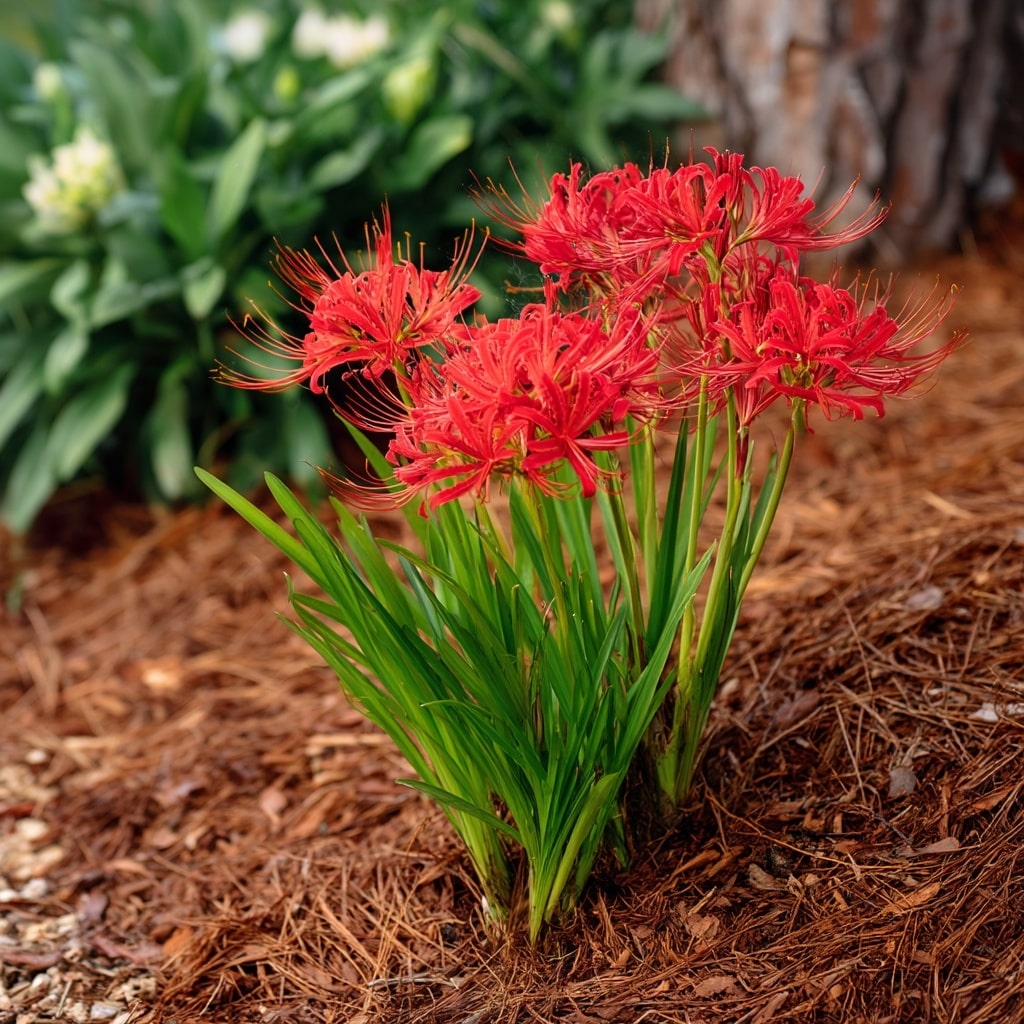
One of the best reasons to grow the spider lily is how trouble-free it is in the garden. This plant is naturally resistant to most pests and diseases, making it a smart choice for both beginner and seasoned gardeners.
Few Pest Problems
Spider lilies are rarely bothered by insects. Their bulbs and foliage are unappealing to deer, rabbits, and other wildlife, thanks to natural alkaloids that make them mildly toxic if ingested. This natural deterrent helps keep your plantings safe in landscapes where wildlife browsing is a common issue.
Disease Resistance
There are no major diseases that commonly affect spider lilies. As long as they are planted in well-draining soil, root rot is unlikely. The biggest potential issue is overwatering during dormancy, which can lead to bulb rot or fungal problems.
💧 Pro Tip: If you garden in an area with heavy clay soil, amend with compost or plant bulbs in raised beds to improve drainage.
Container Caveats
As mentioned earlier, spider lilies don’t thrive in cramped pots. Shallow or narrow containers can limit root development, which often results in stunted growth and no flowers. If you must grow them in containers, choose deep, wide pots and avoid disturbing the bulbs once they’re established.
In general, with proper planting and minimal attention, the spider lily is one of the easiest flowering bulbs to grow and enjoy, year after year.
Landscape Uses – Where to Plant Spider Lily Red for Best Impact
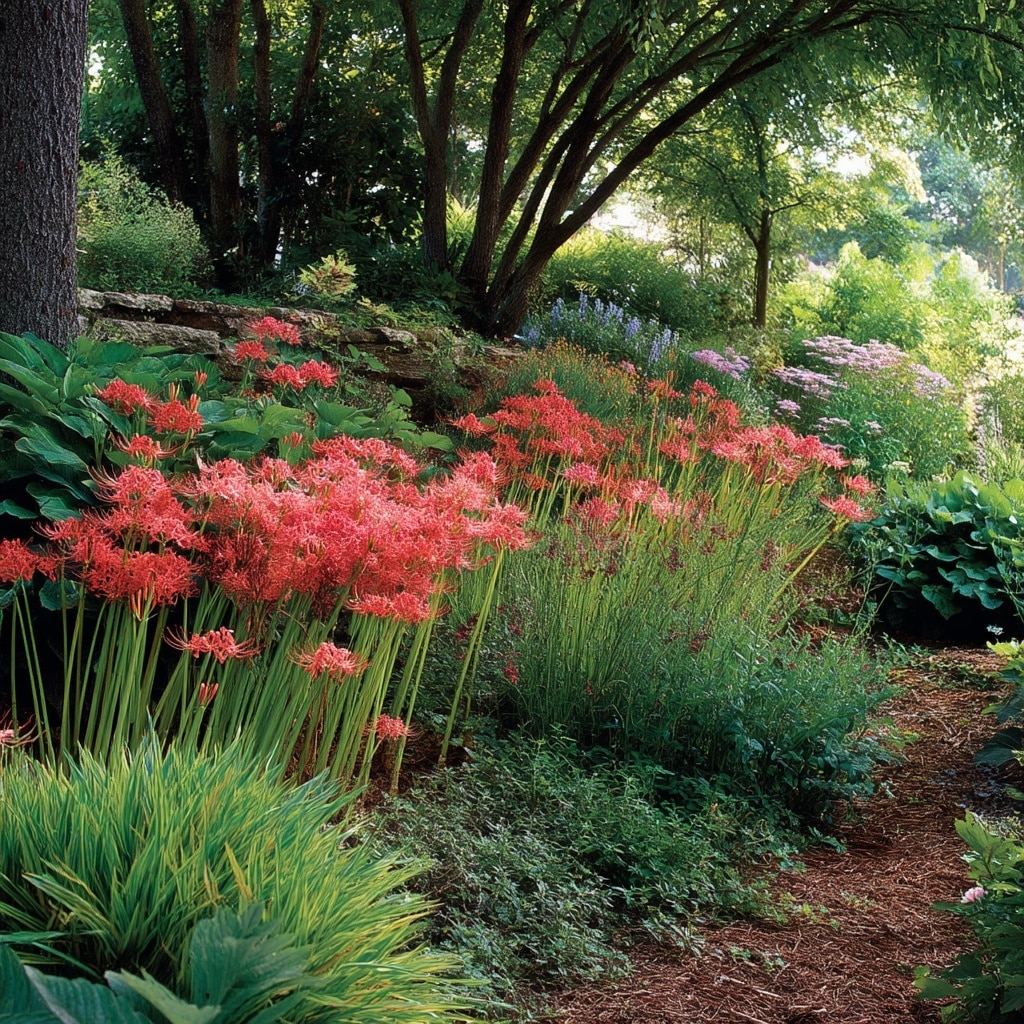
With its vibrant red flowers and unexpected bloom time, the spider lily adds a touch of drama to almost any outdoor space. Whether you’re designing a formal bed, a woodland garden, or a low-maintenance border, this versatile bulb can find a perfect home.
Best Planting Locations
- Mixed borders: Plant among perennials that flower earlier in the season, allowing spider lilies to take center stage in late summer.
- Naturalized areas: Let bulbs spread freely under trees or along woodland edges where partial shade and dappled light help them thrive.
- Walkways and pathways: Plant in small clusters for a surprise burst of color as you stroll through the garden.
- Rock gardens and raised beds: Excellent for ensuring good drainage and showcasing the plant’s unique flower form.
- Beneath deciduous trees: Spider lilies bloom and grow before tree leaves return, making use of the early fall sunlight.
Companion Plants
Because spider lilies emerge and bloom on their own timeline, they pair well with:
- Spring-flowering bulbs (e.g., daffodils, crocuses)
- Summer perennials like coneflower or black-eyed Susan
- Groundcovers like liriope or creeping Jenny, which provide color after the lilies fade
Conclusion
The spider lily is more than just a pretty bloom—it’s a reliable, low-maintenance, and eye-catching addition to any late-season garden. Its unexpected flowering pattern, wildlife appeal, and resilience make it a standout choice for gardeners across a wide range of climates. Once planted, these bulbs come back year after year with minimal care, rewarding you with bursts of fiery red when you least expect it.
Whether you’re planting a few in a container or letting them naturalize beneath trees, the spider lily is a plant that brings both beauty and surprise to your outdoor space.

